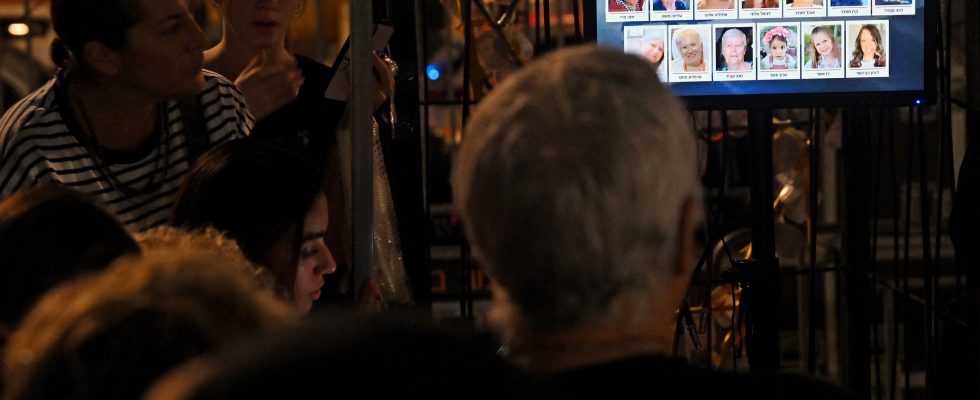It was around 7 p.m. (6 p.m. Paris time) that Israel confirmed the information. The 13 hostages released by Hamas were now “in Israeli territory”, after a day when they were transferred without incident to the Jewish state from Gaza, where they had been held since October 7.
It was first the International Committee of the Red Cross (ICRC) which ensured their movement this Friday afternoon in ambulances to the Rafah terminal, on the border between Gaza and Egypt. The hostages released by Hamas finally arrived in the evening “in Israeli territory”, announced the Israeli army, saying they “welcome their return home” as part of the agreement signed with the Palestinian Islamist movement this Wednesday.
In the morning, Ziv Agmon, advisor in charge of the file to the office of Israeli Prime Minister Benjamin Netanyahu, indicated that the Israeli hostages would only be reunited with their families after their arrival in one of the country’s hospitals prepared to welcome them . “Those who do not need care will return home,” he added.
39 Palestinian prisoners released
A document published by the Office of Israeli Prime Minister Benjamin Netanyahu mentions the names of the 13 hostages released this Friday. Among them are a 34-year-old mother and her two daughters aged 2 and 4, an 85-year-old woman as well as a three-generation family, the grandmother, her daughter and her grandson. No man was released.
Benjamin Netanyahu reacted to this first day of truce, affirming that he and his government were “determined to bring all (the) hostages” into the hands of Hamas. “This is one of the objectives of the war and we are determined to achieve all the objectives of the war,” the Israeli prime minister said in a statement.
At the same time, as planned in the truce agreement, “39 women and children detained in Israeli prisons” were also released, announced the Qatari Ministry of Foreign Affairs. AFP journalists saw buses leaving the Israeli Ofer prison in the occupied West Bank, where prisoners had been transferred for release. Twenty-eight of them were dropped off in the West Bank, while eleven others were taken to occupied East Jerusalem, the NGO said.
11 other hostages freed by Hamas
At the same time and on the sidelines of the main agreement, ten Thais and a Filipino also held hostage by Hamas were released, according to the Qatari Ministry of Foreign Affairs, an announcement that a source close to Hamas described as “a gesture” from the Islamist movement to the AFP.
This announcement is in fact not directly linked to the negotiations carried out around Qatar for a truce in the conflict in Gaza, and these releases are not part of the 50 hostages who must be released by Hamas within four days. The Bangkok authorities are said to have carried out their own negotiations with Hamas, notably thanks to the help of Iran.
A break from the fighting
The truce signed between Israel and Hamas began at dawn this Friday morning, a first lull in the fighting which has now raged for more than six weeks. Thus, at first light, when the incessant airstrikes for nearly 50 days had stopped, like the rocket fire towards Israel from Gaza, tens of thousands of Palestinians displaced in the south of the territory had already gathered their personal belongings to return to their villages.
But as cars and carts set off towards the north of the enclave, leaflets in Arabic launched from the air by the Israeli army warned: “The war is not over yet”, or even “Return to the North is forbidden.” The army considers the northern Gaza Strip, from where hundreds of thousands of Palestinians have fled to the south, as a combat zone where Hamas is headquartered.
On the front between Israel and Lebanon, where Hezbollah is located, the fighting also seemed to have stopped this Friday. Calm reigned in this border area after the truce came into force, according to the official Lebanese agency, residents and an AFP photographer. The latter indicated that he heard exchanges of fire ten minutes before the truce came into force in Gaza, before calm returned.
137 humanitarian aid trucks unloaded
This truce was also to allow the entry of a greater number of aid convoys into the Gaza Strip where, according to the UN, 1.7 million of the 2.4 million inhabitants have been displaced by the war.
The United Nations agency responsible for humanitarian coordination (OCHA) welcomed that this pause in the fighting had allowed the UN to “increase” the delivery of humanitarian aid to the enclave, where 137 trucks have already been discharged.
This delivery constitutes the “largest humanitarian convoy” since the start of the conflict between Israel and Hamas on October 7, adds OCHA in a press release. It specifies that 129,000 liters of fuel were also able to cross the border into Gaza, and that 21 patients in critical situations were evacuated from the north of the enclave.
